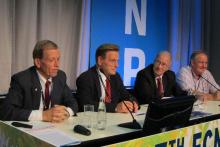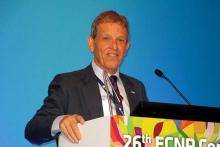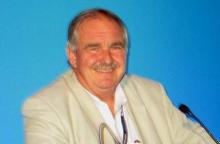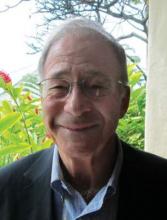BERLIN – Official representatives of the world’s major neuropsychopharmacology organizations have grabbed their shovels in order to bury the time-honored and familiar terminology for the psychotropic medication categories, including “antipsychotics,” “anxiolytics,” “antidepressants,” and “hypnotics.”
These descriptors have long outlived their usefulness and are headed for the scrap heap, according to members of an international task force that unveiled a new neuroscience-based drug terminology at the annual congress of the European College of Neuropsychopharmacology.
“Our psychiatric medication nomenclature is hopelessly outdated. It is 50 years old. We are stuck in the 1960s,” explained Dr. Joseph Zohar, chair of the Joint Task Force on Nomenclature.
The old nomenclature neither reflects current scientific knowledge nor provides clinicians with pharmacologic information useful in making informed treatment decisions. And it certainly doesn’t help patients understand their physician’s rationale in choosing a particular medication.
“We talk about antidepressants, but many times, we give them for anxiety. We talk about antipsychotics, but often prescribe them for depression or anxiety. So the situation we face on almost a daily basis is the anxious patient asking us, ‘Why are you giving me an antidepressant for my anxiety?’ And which is even worse: the depressed patient asking, ‘Is my condition so bad that you’re giving me an antipsychotic?’ This has negative implications for compliance,” observed Dr. Zohar, director of the Anxiety and Obsessive Compulsive Clinic at Sheba Medical Center in Tel Hashomer, Israel.
Likewise, the widely used term “second-generation antipsychotic” is problematic. It encompasses compounds with fundamentally different pharmacologies, and clinicians unaware of that can unwittingly use these agents inappropriately.
“The term ‘second-generation antipsychotic’ is a marketing term. It’s not science,” he asserted.
The task force has created a new nomenclature along the lines of what’s used for antihypertensive medications, where a drug’s class – be it angiotensin-converting enzyme inhibitor, calcium channel blocker, diuretic, or beta-blocker – describes its mechanism of action. That way, when it becomes necessary to add a second or third antihypertensive agent in order to adequately control a patient’s blood pressure, a physician can pick agents having different mechanisms of action to maximize effectiveness and minimize side effects. That’s how it should work in biologic psychiatry, too, Dr. Zohar continued.
The new neuroscience-based nomenclature template has four components. Axis 1 describes the drug’s pharmacologic target and mode of action; to date, there are 11 possible pharmacologic targets and 10 modes of action. Axis 2 describes the drug’s approved indications. Axis 3 summarizes the panel’s collective opinion on the drug’s efficacy, which may extend beyond the approved indications, as for example, with the tricyclic antidepressants, as well as the drug’s major side effects. And Axis 4, which will mainly be of interest to neuroscientists rather than clinicians and patients, details the drug’s neurobiology. Take, for example, flurazepam (Dalmane). It’s often called an anxiolytic. That’s going to change, said task force member Dr. David J. Nutt, professor and head of the center for neuropsychopharmacology at Hammersmith Hospital, London.
“We wouldn’t any longer say ‘flurazepam is an anxiolytic.’ What we’d say is ‘flurazepam is one treatment for anxiety, and it works through being a positive allosteric modulator at the GABA-A receptor,’ ” he explained.
The task force comprises representatives from the ECNP, the American College of Neuropsychopharmacology (ACNP), the Asian College of Neuropsychopharmacology, the International College of Neuropsychopharmacology, and the International Union of Basic and Clinical Pharmacology.
The launch of the new nomenclature at the ACNP meeting was accompanied by release of the NbNomenclature app, which details the new terminology for 108 psychotropic drugs and is downloadable free at the App Store and Google Play. A paperback book covering the same material is also available.
Brandishing the book, Dr. Zohar declared, “We want this to be the DSM-5 of psychopharmacology.” That drew a wince from Dr. David J. Kupfer, the ACNP representative on the task force. As chair of the American Psychiatric Association’s task force for DSM-5, he had requested feedback as that controversial update took shape and wound up getting 14,000 responses, many quite critical. He’s not expecting anything of the sort in response to the proposed neuroscience-based drug nomenclature.
“It’s very clear that clinicians want this,” the psychiatrist said. “I think the scientific response will be very positive.”
The task force does, however, want the new nomenclature to be user friendly. Feedback is welcomed. The panel plans to meet at least once every 6 months to review outside comments and make thoughtful changes to the app, he added.





